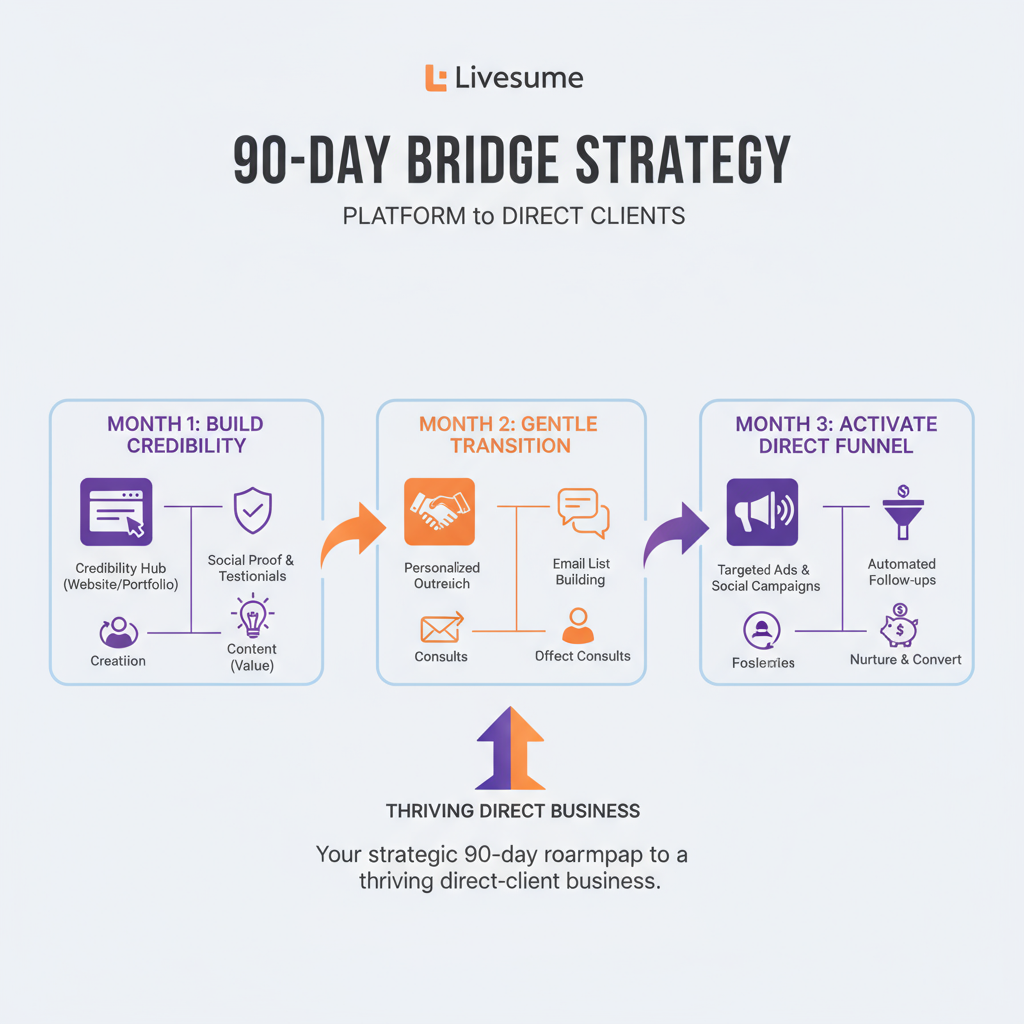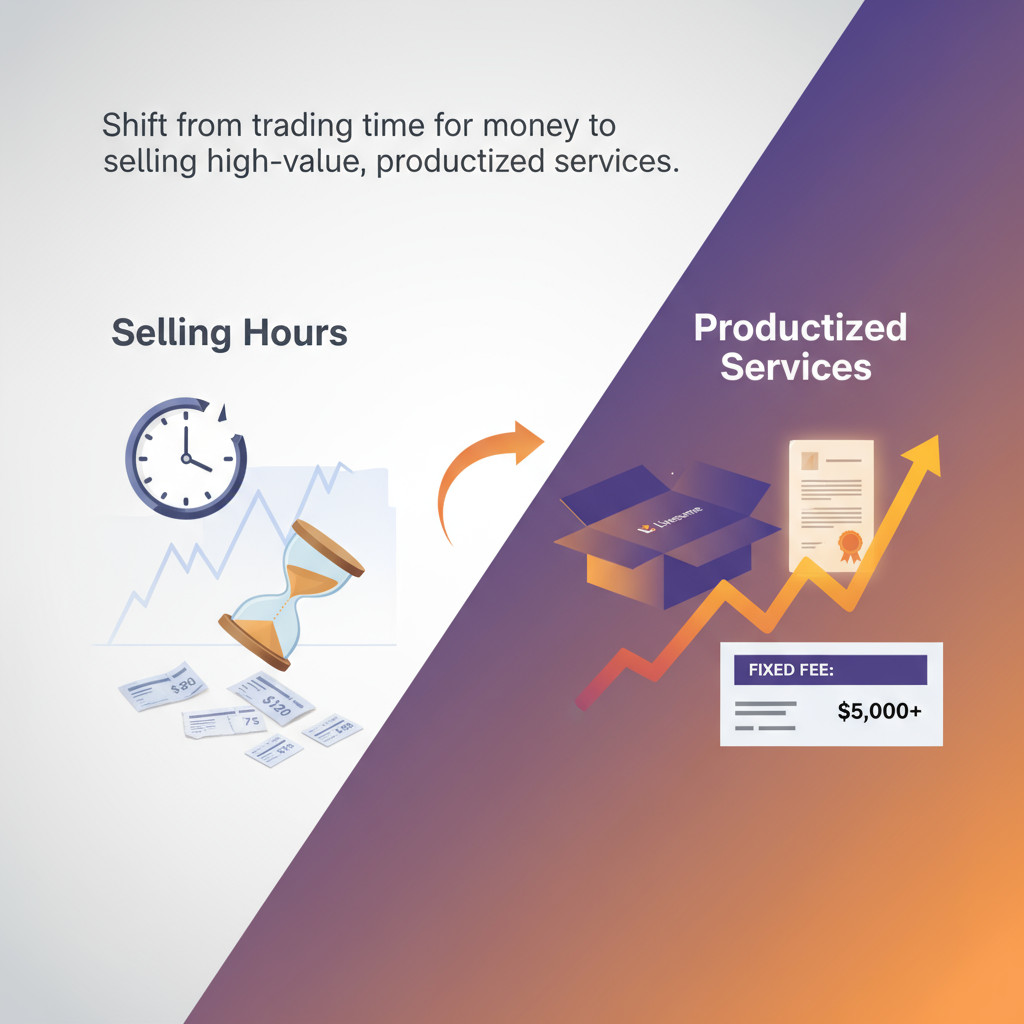Does seeing that 10-20% "service fee" disappear from your Upwork earnings make you cringe? You did the work, you landed the client, yet a chunk of your income vanishes before it ever hits your bank account. You're not just a freelancer; you're renting your clients from a platform that gets paid no matter what. This guide is your way out. We’ll map out a clear, 90-day plan to transition from platform dependency to a profitable, independent business you truly own.
Key Takeaways
- Own Your Business, Not Just Your Gig: Transition from "renting" clients on platforms to building a direct-client business where you keep what you earn.
- The 90-Day Bridge Strategy: A phased, low-risk plan to build your direct client funnel while still leveraging platforms for initial lead flow.
- Build a "Client-Closing" Asset: Your professional page isn't just a portfolio; it’s a machine for converting prospects into high-value partners without a middleman.
- The Zero-Fee Tech Stack: Ditch expensive, complex software. We'll show you a minimalist toolkit (Livesume, Calendly, Stripe) to manage your entire client lifecycle for a fraction of platform fees.
- Shift to Productized Services: Stop trading time for money. Packaging your expertise into fixed-price services makes it dramatically easier to sell directly and command higher rates.

Why You're Losing Money by Renting Your Clients
Let's be blunt: freelance platforms are brilliant for getting started, but they become a tax on your growth. That 10-20% fee isn't just a number; it's a direct brake on your earning potential. As platform rules get stricter and the cost of "Connects" or bidding rises, the risk of depending on one source of income becomes too high.
Think about it in real numbers. Before, a $5,000 project on Upwork might net you $4,500 or even just $4,000 after fees. After you go direct, that same $5,000 project, paid via Stripe, puts about $4,855 in your pocket. That’s an extra $355-$855 from a single project, just by changing how you get paid. Now, multiply that across a year.
The real goal isn't just to leave Upwork; it's to build a resilient business that you control. That starts with a plan.
The 90-Day Bridge Strategy: From Platform Gig to Direct Partnership
This isn't about deleting your profile tomorrow. It's a strategic, phased transition that uses the platform as a launchpad, not a cage. We call it the Bridge Strategy. Here’s how it works.
Month 1: Build Your Credibility Hub (Days 1-30)
Your first move is to create a single, powerful destination that screams professionalism and makes potential clients feel confident hiring you directly. This is your client-closing landing page, and it needs to do more than just show your work.
- Consolidate Your Proof: Pull your best testimonials, case studies, and portfolio pieces from Upwork, LinkedIn, and anywhere else they live. House them on your Livesume page to create an undeniable wall of social proof.
- Clarify Your Offer: Stop being a generalist. Define your niche and craft a compelling one-sentence value proposition. Who do you help, and what problem do you solve for them? Make it the headline on your page.
- Integrate Your Call to Action: Don't just show your work; tell prospects what to do next. Add a Calendly link to your page for "15-minute intro calls." This removes all friction from the first conversation.
Month 2: The Gentle Transition (Days 31-60)
Now that you have a professional home base, you can start strategically moving relationships off-platform. The key is to do this professionally and ethically, focusing on clients you have a strong, existing relationship with and whose projects are complete on the platform.
When a client you love working with hints at future projects, you can say: "I've really enjoyed working on this. For future collaborations, I'm now managing all my projects through my own system. It's more streamlined and allows for more flexibility. You can see my work and book time directly through my professional page here." You're not poaching; you're graduating.
Ready to Build Your Client-Closing Asset?
Your journey to freelance freedom starts with a powerful, professional online presence. Create your free Livesume page in the next 15 minutes and turn platform gigs into a direct-client business you own.
Start Building for Free
Month 3: Activate Your Direct Client Funnel (Days 61-90)
With your credibility hub live and your transition process tested, it’s time to generate new, direct leads. Your platform profiles now become billboards that point to your professional page. Update your Upwork and LinkedIn bios to mention your primary business or personal site.
Start dedicating a few hours each week to activities that drive traffic to your Livesume page:
- Lightweight Content: Share your expertise on LinkedIn or Medium, always linking back to your portfolio or services page.
- Targeted Outreach: Identify 10 ideal companies and use AI tools like Clay or Lavender to personalize outreach emails that reference their specific needs and point to a relevant case study on your site.
- Engage in Niche Communities: Participate in Slack groups, subreddits, or forums where your ideal clients hang out. Be helpful, not salesy, and let your profile link do the talking.

Your Zero-Fee Tech Stack: The Minimalist Toolkit for Independence
You don't need a complex and expensive CRM to run your freelance business. The goal is a lean, effective stack that automates the boring stuff and lets you focus on high-value work.
- Your Hub: Livesume. This is your digital storefront, portfolio, and credibility center all in one.
- Scheduling: Calendly. Embed it on your Livesume page to create a zero-touch onboarding system for intro calls. No more back-and-forth emails.
- Payments: Stripe or Wise. Create professional invoices and accept payments for a tiny fraction (around 2.9%) of what platforms charge.
- Project Management: Notion or Trello. Create a simple, shared board for each client to track progress, share files, and keep communication organized.
Sell Outcomes, Not Hours: The Power of Productized Services
One of the biggest levers for going direct is changing *what* you sell. Instead of selling hours, which clients always try to negotiate down, sell a fixed-scope, fixed-price package. This is a productized service.
Before: "I'm a web designer for $75/hour." This invites haggling and scope creep.
After: "I offer a 'Startup Landing Page Package' for $5,000. It includes brand strategy, copywriting, design, and development for a 5-page site, delivered in 4 weeks." This is a confident, outcome-focused offer that's easy for a client to understand and approve. It positions you as an expert, not a temp. Use your Livesume services page to clearly define these packages.

Frequently Asked Questions (FAQ)
1. Is it against Upwork's terms of service to take clients direct?
It's against Upwork's TOS to take a client you *met on the platform* off the platform within 24 months, unless you pay a buyout fee. However, this plan focuses on using your profile to attract clients to *your* independent system and transitioning long-term clients after contracts are complete, which is a gray area many successful freelancers navigate carefully.
2. How much does Upwork charge in fees in 2025?
As of early 2025, Upwork's freelancer service fees are still structured on a sliding scale based on lifetime billings with a client: 20% for the first $500, 10% for billings between $500.01 and $10,000, and 5% for billings over $10,000. There are also fees for withdrawing funds and purchasing "Connects" to apply for jobs.
3. What is the best way to get direct clients as a freelancer?
The best way is to build a strong professional presence (like a Livesume page) that showcases your expertise and results. Then, drive traffic to it through channels you own, like targeted outreach, content creation on platforms like LinkedIn, and networking in niche online communities.
4. How do I convince a client to work with me directly?
Don't "convince," but rather "invite." Frame it as a benefit to them. Mention things like "a more streamlined process," "direct communication," or "more flexible payment options (like 50/50 invoicing)." A professional setup with clear contracts and a dedicated portfolio page makes them feel secure.
5. What are the alternatives to using Upwork or Fiverr?
Besides building your own direct client funnel, you can explore niche marketplaces (like Toptal for developers or MarketerHire for marketers), professional networking on LinkedIn, cold outreach, and joining curated freelancer collectives.
6. How do I create a contract for a direct client?
You don't need to hire a lawyer for every project. Use reputable templates from sources like Bonsai, And.co, or even the AIGA Standard Form of Agreement for designers. The key is to clearly outline the scope of work, deliverables, payment terms, and timeline.
7. What payment processor is best for freelancers with direct clients?
Stripe is the gold standard for most freelancers. It's trusted, easy to integrate with invoicing software, and has transparent pricing (typically 2.9% + 30¢ per transaction). Wise (formerly TransferWise) is an excellent option for international clients due to its low currency conversion fees.
8. How long does it take to replace my income from freelance platforms?
Our 90-day plan is designed to make a significant dent, but a full replacement can take anywhere from 3 to 6 months, depending on your niche, pricing, and the effort you put into marketing your new direct funnel. The key is consistent effort.
Turn Your Plan Into Action: Your First Steps to Freedom
Reading this is one thing; doing it is another. True independence from platform fees doesn't happen by accident. It happens by building assets you own and systems you control.
Don't wait. Take the first, most crucial step today:
- Create Your Livesume Page: Sign up for free and pull in your best work and testimonials. This is your new home base.
- Define One Productized Service: Pick your most requested service and package it with a clear scope and price. Add it to your page.
- Update Your Social Profiles: Change the link in your LinkedIn and Twitter bios to point directly to your new Livesume page.
You now have a functional funnel to start capturing direct interest. You're no longer just a profile in a directory; you're a business owner with a destination. That's the first real step to keeping what you earn.